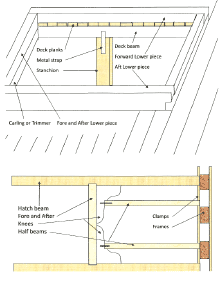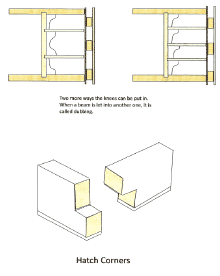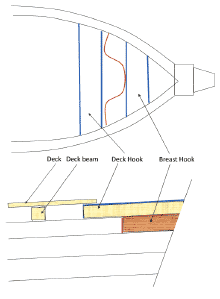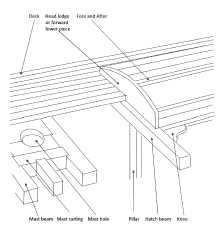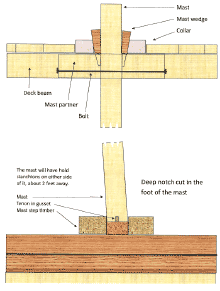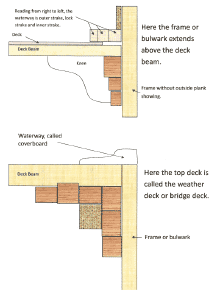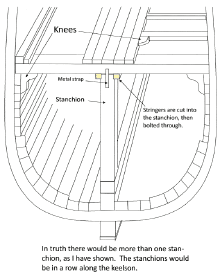
 Custom Search
|
|
| sails |
| plans |
| epoxy |
| rope/line |
| hardware |
| canoe/Kayak |
| sailmaking |
| materials |
| models |
| media |
| tools |
| gear |
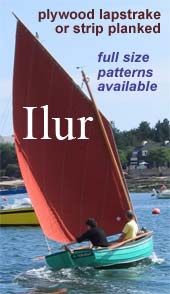 |
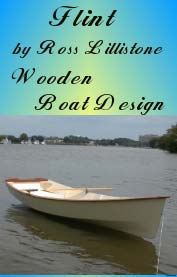 |
| join |
| home |
| indexes |
| classifieds |
| calendar |
| archives |
| about |
| links |
| Join Duckworks Get free newsletter Comment on articles CLICK HERE |
|
|
| Out There |
by Paul Austin - Dallas, Texas - USA Classic Ship Construction Notes - Part Five |
 |
Part One - Part Two - Part Three - Part Four - Part Five- Part Six Deck Beams, Knees, Stanchion and Mast HoleNow we come to the deck. The deck beams from side to side have to be cut in a camber, which is usually 1/4 inch for every foot of length. The camber is not cut along the entire length of the beam, only the middle. When the beam is in place, the middle is sprung up, called 'pumping the beam.' This pumping amounts to 1/8th of an inch for every foot of length. Usually, ships of this size have their beams pumped about 4 to 5 inches. Only the top of the beam is cambered, the bottom is left straight resulting in strength. It will bend, but as it is straight the fibers will simply cram themselves together, thus tightening the beam. The exception to this are the shorter beams, whose bottom is cut in a camber parallel to the top. A beam mold is made, to the dimensions of the main frame. Its' camber will be scribed on all beams except those at the stern. As the ship's deck narrows at the stern, such a camber would make the stern look like a hump. How much the deck beams at the stern flatten is up to the shipwright. No rule has been given. Some ships have their deck beams astern drop into a lower position on the frames with a gradual flattening of the beam camber. At the very stern the deck beam could be perfectly straight.
On the west coast of the US, hanging knees were fastened to support the deck beams. This was not done on the east coast, as there was not such a great supply of crook in fir. Crooks are cut from the roots of the tree, and they are quite strong. The short leg of the knee is the root, the long leg is called the trunk. Usually up to 20 bolts are driven through the knee into the outer planking. The arrangement is not standard, whatever the shipwright wants will be done. Where the deck beam sits on a knee, with bolts everywhere, care must be taken to know where previous bolts have been driven. Important pieces of stout wood can be weakened to the point of crumbling in the bolt holes if there are too many bolts too close.
Where deck beams form one side of a hatch, they are called hatch beams. Deck planking will lay on top of the hatch beam for the width of the hatch beam, and on top of the decking will be the header. This header is also called the forward lower piece. The fore and after, also called a lower, runs from the forward lower piece aft along the hatch opening. Then the aft lower piece completes the rectangular opening. While the hold stanchion is erected in a significant place under the deck on the keel line, sometimes a large hatch needs additional support. These support members, sitting up on the keel in line with the hold stanchion, are called pillars. They sit underneath the hatch beam at the forward and after end. They are not as thick or sometimes as tall as hold stanchions.
How about a little controversy? Breast hook or deck hook? In some shipbuilding sites this is the same triangular piece cut out of a natural crook knee. However, on big ships the two are different. The deck hook is a series of short thick beams laying against the apron and on top of the clamp at the bow. They connect the decking, clamps and stem. But the breast hook is cut from a natural crook knee. It sits below the deck hook as one piece. This is the piece found on many smaller craft.
Mast partners require a few more steps in big ships. Their top and bottom of the partner must match the deck camber and the mast is never exactly perpendicular to the keelson. Before the raking masts of the Baltimore clipper schooners, masts were angled off perpendicular 1/4 inch to 3/8 inch for every foot from the keelson to the deck. A preliminary hole in the mast partner is cut to drop a line from it to the keelson by which the mast rake is measured. The length of the line when it is dropped straight down tells the shipwright the distance from mast partner to keelson. Then with the 3/8 or 1/4 inch per foot, the angle of mast rake can be determined.
Then the full mast hole is cut larger than the mast diameter to make room for the mast wedges. Bolts are cut from outside one beam through the mast partners and through the other beam. A covering board is installed underneath the beam-partner-beam surface. As the deck beams are put in and cambered, hundreds of chocks are dubbed into them. Chocks don't go everywhere between deck beams but only under deck fittings such as hatches, vent pipes, stairways and mast partners. They also are fitted in where the planking ends between beams at the stem and stern.
Now we come to waterways. These are strakes on top of the deck beams to take water away. They guide water on the deck toward the scuppers. Waterways are also the name of the strake which covers the top of the frame as it comes up above the top deck. Here it is also called a covering board, since it covers the exposed wood of the frame. On some ship plans, where the frame rises above the top deck is called a stanchion. This is not the 'hold' stanchion which sits on the keelson underneath deck beams holding them up. Frames above the top deck called stanchions have chocks between them with a tapering to the waterways.
Paul https://crossingthoughts-paul.blogspot.com.au ***** |
